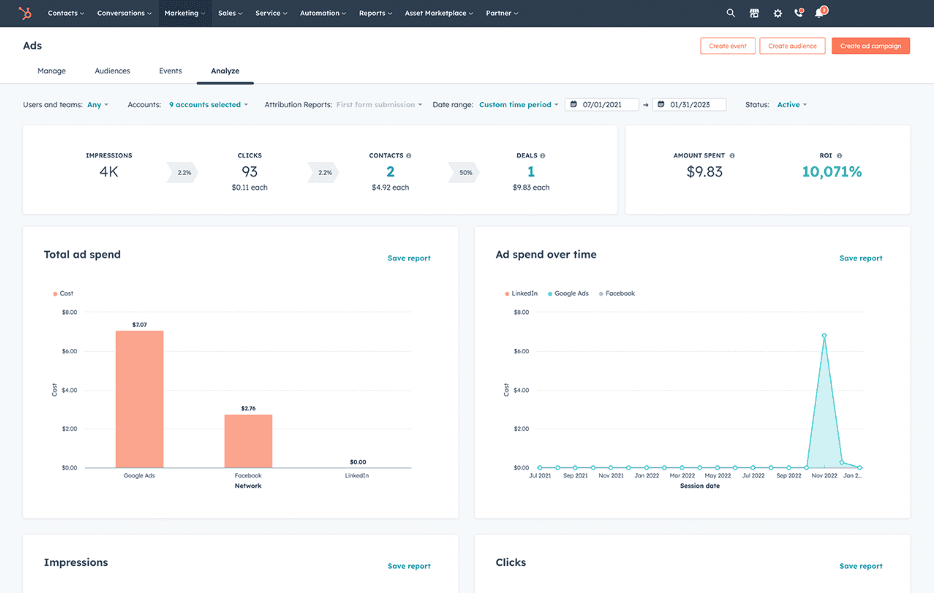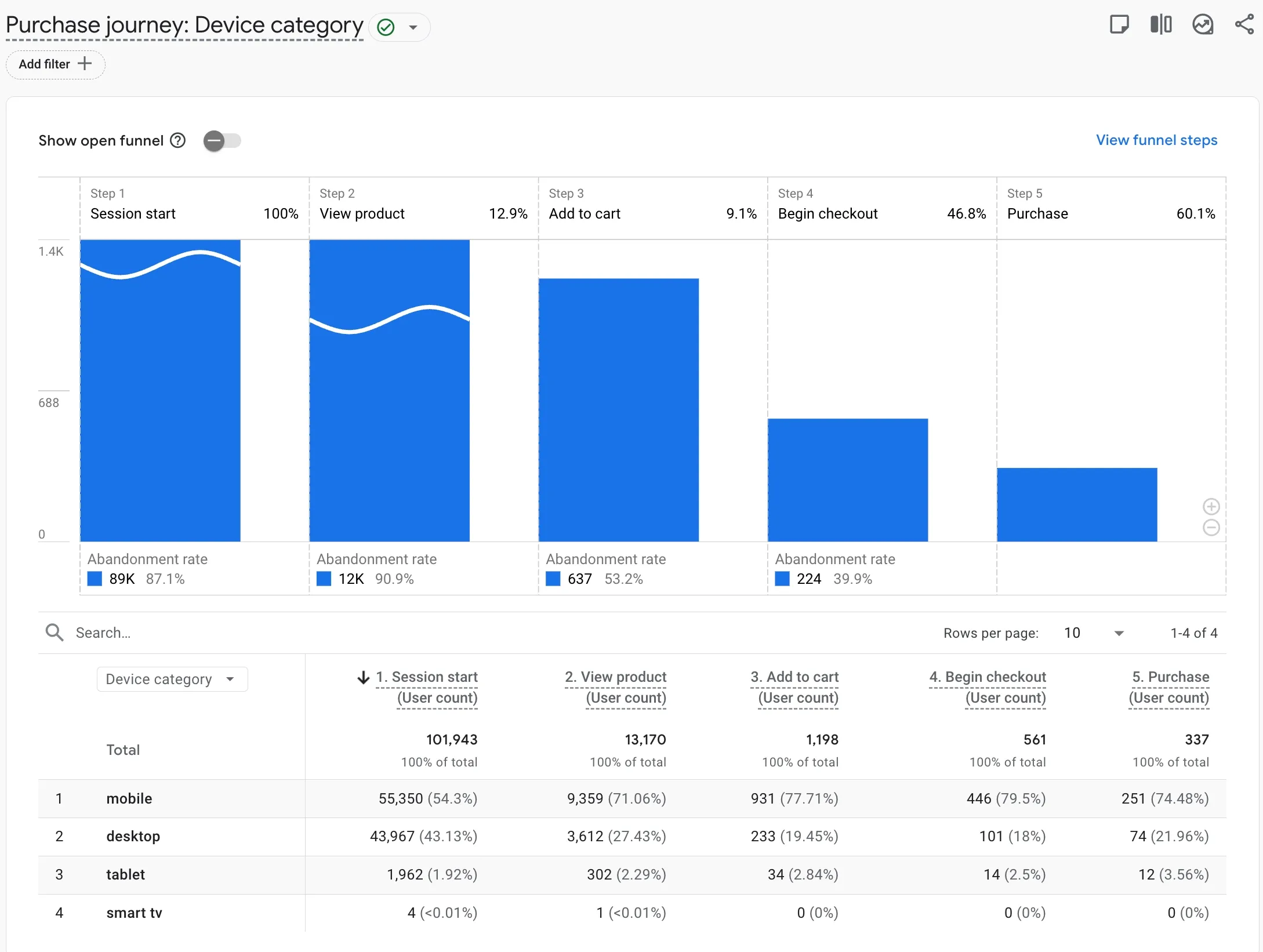HubSpot vs GA4: Which Analytics Platform Should CMOs Really Trust?

Keep ahead of the curve via our latest trends newsletter.
Contact us nowHubSpot vs GA4: Which Analytics Platform Should CMOs Really Trust?
Short answer: they solve different problems.
Smarter answer: if you want revenue, pipeline and contact-level clarity, the source of truth is HubSpot.
If you need channel performance, page behaviour and customer journey depth, the source of truth is GA4.
If you want the full picture — you use both.
1. Why CMOs Compare HubSpot and GA4 in the First Place
Most teams hit the same wall:
- “Why don’t HubSpot and GA4 match?”
- “Which numbers do we report to the board?”
- “Which tool is ‘right’?”
- “Why does GA4 show more users but HubSpot shows fewer leads?”
These questions always show up when marketing, sales and finance rely on different numbers from different platforms, even though they’re all looking at the same activity. HubSpot and GA4 are built on completely different data models — identity-based vs event-based — which means their outputs are never meant to match, but instead complement each other. Understanding that difference is the unlock that stops internal arguments and creates cleaner reporting for stakeholders.
2. What HubSpot Reporting Does Better
HubSpot wins when revenue matters.
HubSpot’s reporting engine is built around real people, real deals and real dollars. For CMOs, this removes the guesswork that usually comes with channel ROI because HubSpot nests all activity under a single contact identity.
a) Revenue Reporting (Native ROI Insight)
HubSpot tracks revenue to the contact, not to the device.
This means you get:
- Closed-won revenue by source
- MRR attribution
- Deal velocity
- Pipeline contribution
- CAC vs CLV calculations
- Channel profitability

Where GA4 provides directional signals, HubSpot gives commercial certainty because revenue is tied directly to deals and lifecycle stages. It’s the only platform where finance, sales and marketing can align on one view of “what actually made money.”
b) Contact & Lead-Level Reporting (Real People, Not Cookies)
HubSpot stores every contact’s:
- First touch
- Last touch
- Multi-touch path
- Every form submission
- Every email open/click
- Every meeting
- Every sales touch

This level of granularity gives CMOs the visibility they need to track the full lifecycle from anonymous visitor → MQL → SQL → customer. Because the data sits at the CRM layer, the contact timeline becomes the backbone of attribution and removes the ambiguity that comes with anonymous analytics data.
c) ROI Reporting Out of the Box
HubSpot ties:
- Ad spend
- Leads
- Deals
- Revenue
…into one view without extra engineering.
This eliminates the mess of stitching together spreadsheets, UTMs, and platform-reported conversions. A CMO can open HubSpot and know exactly which channels genuinely contributed to pipeline and which ones just generated noise.

3. What GA4 Does Better
GA4 wins when behaviour matters.
It provides a level of granularity around user behaviour that HubSpot is not designed to capture. While HubSpot excels in revenue intelligence, GA4 excels in optimisation intelligence.
a) Page-Level Reporting
CMOs use GA4 to answer:
- What pages convert best?
- Where do users drop off?
- Which channels drive engaged sessions?
- Which pages need CRO work?

This helps teams uncover friction points across the website experience. GA4’s event-based model means every scroll, click, interaction or abandonment event can be measured, which is essential for conversion rate optimisation across funnel stages.
b) Customer Journey Reporting Built In
You get:
- Multi-step funnels
- Time-to-event reporting
- Drop-off visualisation
- Page flows
- Event sequences
These exploration tools give marketers full visibility into how users move through the website, which helps identify where to improve UX, copy, design and CTAs. GA4 becomes the “behaviour microscope” that informs where to allocate CRO and media optimisation effort.
c) Ecommerce Reporting Power
For ecommerce operators, GA4 is essential:
- Product-level revenue
- Checkout behaviour
- Cart abandonment
- Cross-device attribution
- Real-time event analysis

GA4 becomes the heartbeat of ecommerce analytics. Its product-scoped reports help CMOs understand which products drive margin, which funnels underperform, and where users leak during checkout — all insights HubSpot can’t deliver natively.
4. So Which One Should CMOs Trust?
You trust HubSpot for revenue.
You trust GA4 for behaviour.
Use HubSpot when you need:
- Revenue source-of-truth
- Contact-level attribution
- Sales + marketing alignment
- Forecasting & pipeline clarity
- True ROI
HubSpot is the commercial foundation of the business. It aligns the organisation around one number and removes ambiguity about performance. For CMOs, this consistency is critical when dealing with boards, CFOs and CEOs.
Use GA4 when you need:
- UX/CRO insights
- Paid media optimisation
- Landing page performance
- Deep funnel/behaviour insights
- Ecommerce detail
GA4 becomes the operational engine that helps marketing teams sharpen their tactics. Where HubSpot tells you “what happened,” GA4 explains why it happened.
If you’re short on time
HubSpot is the safer “single source of truth.”
If you’re a channel manager
GA4 is non-negotiable.
If you’re serious about growth
You run both, and unite them in HubSpot (your CRM layer).
This two-platform strategy gives CMOs a system for governance (HubSpot) and a system for optimisation (GA4), which is the highest-performing structure for modern digital teams.
5. The Real Reason the Numbers Don’t Match
- GA4 counts events, devices, sessions.
- HubSpot counts people.
This mismatch is expected — and healthy. It’s the natural byproduct of each tool measuring different realities. GA4 spreads a single user’s journey across multiple events; HubSpot collapses that same journey into one identity. When CMOs stop trying to reconcile the two, reporting becomes cleaner and confidence increases dramatically.
6. What We Recommend to CMOs Today
1) Treat HubSpot as your commercial system of record
Board reporting, revenue, profitability and attribution — all live in HubSpot.
2) Treat GA4 as your optimisation environment
CRO, landing pages, channel performance, user journeys — all live in GA4.
3) Connect both into one ecosystem
HubSpot’s ad integrations + GA4 events + server-side tagging = a unified, privacy-safe measurement stack.
4) Stop trying to reconcile them
Use each tool for its purpose.
Trust the metric that fits the question.
Once teams accept this division of roles, accuracy improves, friction disappears and marketing becomes easier to defend commercially.
7. A Simple Framework for CMOs
If the question is “How much revenue did we generate?” → HubSpot.
If the question is “How do we increase conversion?” → GA4.
If the question is “Which channel deserves more budget?” → Use both.
This framework helps CMOs and marketing leaders assign the right tool to the right decision, lowering reporting noise and improving speed to insight.
8. HubSpot vs GA4 — Comparison Table for CMOs
Category | HubSpot | GA4 |
|---|---|---|
Primary Purpose | CRM-based reporting, revenue intelligence, attribution, sales + marketing alignment | Behaviour tracking, funnel insights, page performance, UX/CRO optimisation |
Data Model | Identity-based (contacts, companies, deals) | Event-based (sessions, events, device interactions) |
Source of Truth For | • Revenue• Pipeline• Lead quality• Marketing → sales handover• MQL → SQL → Customer lifecycle | • Website behaviour• Channel performance• User journeys• Drop-off points• Ecommerce behaviour |
Strengths | • Revenue attribution out of the box• Every interaction tied to a person• End-to-end lifecycle visibility• Aligns sales + marketing in a single system• Native ad integrations (Meta, Google, LinkedIn)• Clean dashboards for executive reporting• Easy to use and interpret• Suitable for non-technical teams | • Advanced funnel exploration• Deep pathing and event sequences• More accurate behavioural insights• Strong ecommerce reporting• Highly granular event tracking• Better at CRO and landing page optimisation• Strong cross-device modelling |
Limitations | • Weaker behavioural / event-level detail• Page analytics are basic• Limited funnel flexibility• Requires strict CRM hygiene• Attribution relies on properly configured UTMs• No native product-level ecommerce reporting | • No revenue reporting unless connected to a CRM or warehouse• Hard for executives to interpret• Data often “looks wrong” if not configured well• Can’t show contact-level journeys• Attribution models vary widely• More technical to maintain |
Team Fit | • CMOs• Sales leaders• BDMs• RevOps• Marketing managers who need clean reporting | • Performance marketers• CRO specialists• SEO/SEM teams• Product teams• Ecommerce operators |
What It Does Better | • Ties deals to sources• Shows revenue from marketing• Tracks contacts through funnels• Shows ROI by channel• Connects marketing → sales → revenue | • Tracks user behaviour• Identifies drop-off points• Shows path patterns• Visualises multi-step funnels• Shows product interactions |
What It Struggles With | • Behavioural data• Detailed pathing• Multi-layer funnels | • Revenue clarity• Cohesive customer identity• Multi-system alignment |
Setup Complexity | Low to medium | Medium to high |
Accuracy Caveats | Relies on clean CRM management, accurate UTMs, correct ad connections | Relies on correct events, consent mode, cross-device modelling, cookie behaviour |
Best Used For | Board reporting, revenue attribution, channel ROI, lifecycle analysis, forecasting | CRO, content optimisation, landing pages, event tracking, ecommerce analysis |
When Not to Use | For pure behavioural analysis or funnel exploration | As your revenue source-of-truth |
Who Should “Own” It | Marketing + Sales + Leadership | Performance + CRO + Product teams |
Ready to See the Bigger Picture?
Want to understand how your digital and real-world marketing impact each other? Not sure if your CRM is supporting your paid media efforts? Just need some clarity and a clear plan to better ROI? Book your free strategy session today for an in-depth audit and action plan to double your digital marketing ROI.
- Meet with a strategy specialist to build a growth plan
- Increase your media performance by up to 200%
- Improve business efficiencies to increase ROI via automation and increase profit
- We cut to the chase. What digital marketing is actually working?
